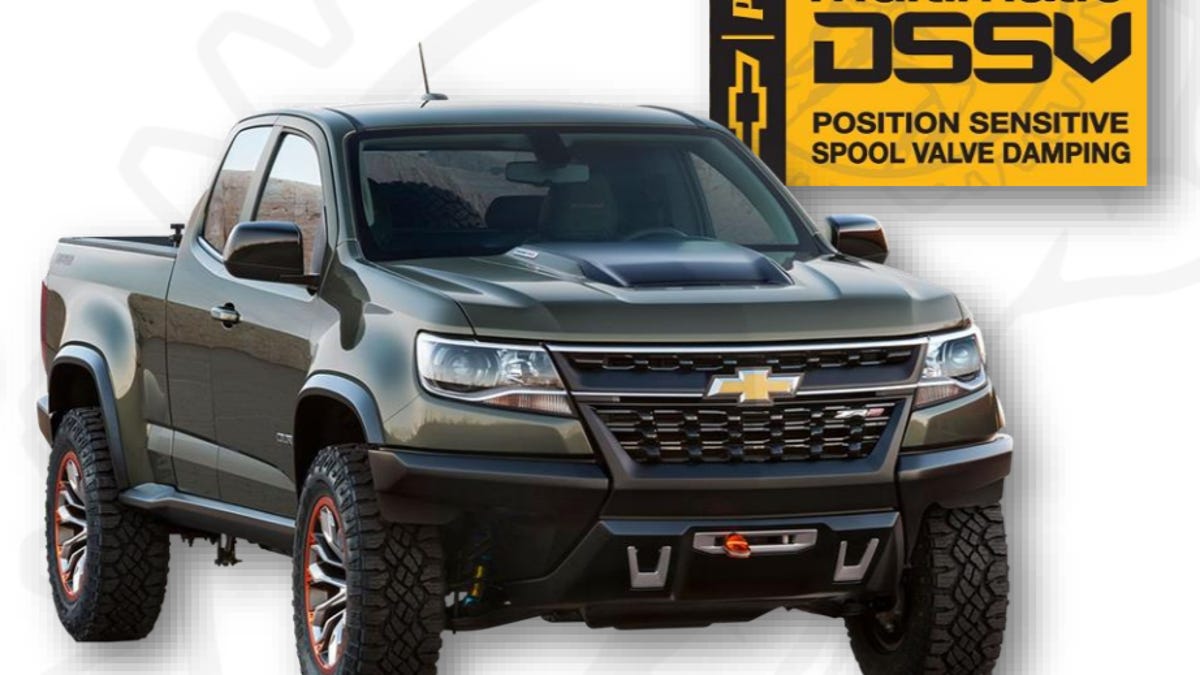Chevrolet Colorado ZR2's advanced suspension makes Formula One weep
The performance halo for Chevy's truck family features Multimatic's position-sensitive DSSV dampers that are inspired by (and technically more advanced than) Formula One racing technology.

It's fitting that the Chevrolet Colorado ZR2, the performance halo for Chevy 's truck family, would make its debut here in at the 2016 Los Angeles Auto Show . The midsize pickup was first introduced at 2013 LA show, and we got our first peek at the ZR2 in concept form here in 2014. It's practically a tradition at this point.
Like the Camaro ZL1 and Corvette ZR1, the letter "Z" means that this Colorado ZR2 is the highest-performance variant of the Colorado truck. The ZR2 will obviously feature powertrain enhancements, but the thing that's got me most geeked out is the crazy innovative suspension that underpins the performance truck.
Chevy could have chosen an established off-road suspension player like Fox or King but it went a different direction, tapping its relationship with the road racing suspension engineers at Multimatic -- the team responsible for dampers in the Camaro Z/28 -- to build for the Colorado ZR2 a no-compromise suspension for on and off road.
I got an inside look at how this Formula One-inspired suspension works. Buckle up, we've gotta get nerdy before we get dirty.
The Multimatic DSSV
The innovation that earned Multimatic its racing pedigree as the damper of choice for various Formula One and Le Mans teams is its Dynamic Suspensions Spool Valve (DSSV).
The way conventional dampers (sometimes known as shock absorbers) work is simple: there's a piston with holes in it shoved into a sealed tube filled with oil. The piston's holes are covered with metal shims, which slows the movement of the piston through the oil as the suspension moves, but if the suspension is pushed hard enough, the shims defect allowing the piston to momentarily move more freely. As I said, it's simple, but it's also difficult for engineers to tune, and quite low tech.
The DSSV on the right uses a spring valve and a shaped "keyhole" to offer better control than the shim valve (left).
Multimatic's DSSV replaces the shim over the holes in the piston with a tiny spring-loaded valve that opens at a variable rate in response to the speed at which the damper's piston moves. It's sort of like a small spring damper inside of the damper. The DSSV allows the suspension to be much more precise and tunable than a shim-valve damper -- but there's more.
The DSSV is also able to be further finessed by changing the shape of the opening that the oil passes through inside the valve; Multimatic calls this the keyhole. By tuning the keyhole, engineers can make the damper firmer or softer for different levels of input force on the suspension. So, the damper can be firm for controlled on-road performance, but instantly become more compliant if a big bump is hit when the truck goes off-road. It's sort of like an electronic active suspension, but with analog engineering.
The ZR2 has three of 'em
When Multimatic builds the dampers for the Camaro Z/28 or the tiny dampers in a Formula One car, it uses two DSSVs: one to control the compression of the shock (when the suspension absorbs an impact) and one to control the rebound (when the impact energy is released). The Colorado ZR2's three-chamber suspension features three DSSVs because the performance truck has to, well, perform both on and off road. It basically has two suspensions in one. It's technically more advanced than Formula One's.
The Colorado ZR2's three-chamber dampers use two DSSVs for on-road performance and a third position-sensitive DSSV with different settings that are optimized for off-road use.
The first two DSSVs, which are in a remote chamber, are for on-road compression and rebound. The third DSSV is in the main chamber and transforms the ZR2's shocks into position-sensitive dampers. It controls suspension compression when the damper experiences the kind of really big bumps you get off road and only comes into play once the suspension has been compressed to a high degree.
There's a fourth, non-DSSV rebound valve in the main chamber that's designed to control suspension movement when transitioning back to load from full, unweighted suspension extension when the Colorado ZR2 goes airborne. It's basically a landing valve for sick jumps. How cool is that?
Multimatic's engineers claim the trio of DSSVs allow an unprecedented amount of tuning flexibility across a variety of impact forces for both on and off-road and for small and large suspension movements. The DSSV setup allows the use of lower internal damper pressures which allows better thermal control and fade resistance and more predictable operation across a wider range of external temperatures and conditions.
Two suspensions in one
Multimatic took all of that tech and put it in hands of Chevrolet's suspension tuners who applied their trophy truck know-how to the Formula One-bred suspension. The result is what Chevrolet claims to be a no-compromises performance truck with a firm and precise suspension on the tarmac that can seamlessly transition to the big suspension travel needed for playing hard in the dirt.
And it does it all with better off-road ruggedness than an electronic adaptive suspension, better thermal management than a magnetic ride control system and less complexity than either.
The new Chevrolet ZR2 debuts at the 2016 LA Auto Show today with the Position Sensitive DSSV suspension underpinning it, and we haven't even gotten to discussing the gasoline and diesel engine specs, the eight-speed automatic transmission or the dual locking differentials. Stay tuned to our coverage for more details as they emerge.

